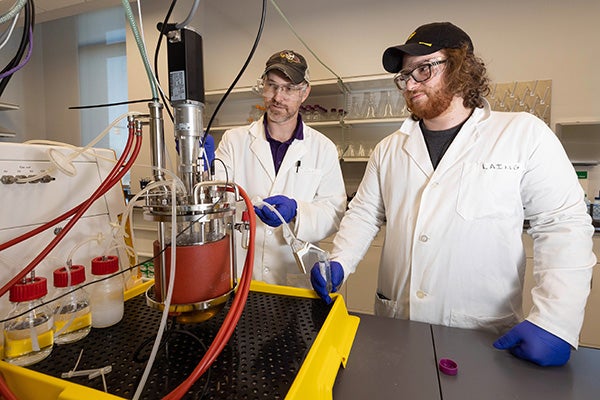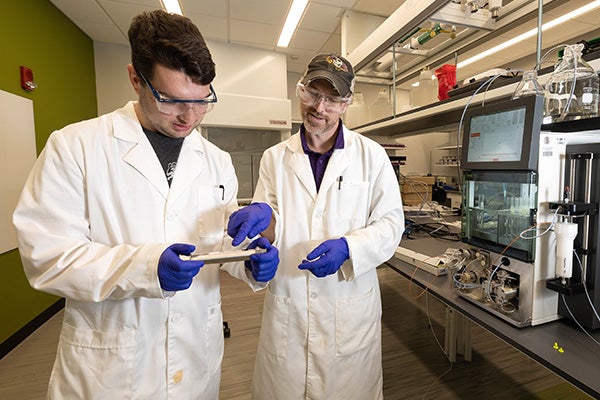New Life Sciences and Biotechnology Building
Bioprocess engineering majors spread their wings in new ECU building
East Carolina University’s Life Sciences and Biotechnology Building opened in November, and bioprocess engineering students are already glowing about the new space.
“It’s really, really cool,” said Luciano DeRose, a junior from Titusville, Pennsylvania. “It’s special that we get to be in here first and pave the way for everybody else.”

Lab supervisor Chris Cone, left, instructs Joseph Laing, a junior bioprocess engineering major from Cary, on the use of a bioreactor in the new Life Sciences and Biotechnology Building.
The Department of Engineering in ECU’s College of Engineering and Technology is one of several departments already making good use of the four-story, 141,500-square-foot building.
For engineering specifically, the new building has given students in bioprocess engineering two separate labs to conduct work, as opposed to the one lab that was available when the program was housed in the Science and Technology Building.
That’s important, said Dr. Loren Limberis, associate professor of engineering and director of the Eastern Region Pharma Center that is also located in the new building. He points to a growing pharmaceutical industry that relies on bioprocess engineers to help produce the medicine that can improve or save lives.
North Carolina has seen roughly 9,600 new biotechnology jobs in the last two years, according to the North Carolina Biotechnology Center. North Carolina is the third largest state in the nation for biopharma jobs.
“The university has put a lot of resources into the engineering program, focusing on biotechnology and bioprocessing because they see this explosion in the market in terms of job opportunities,” Limberis said. “To satisfy demand in the industry, to maintain pace in this expansion and growth in the state, and to provide career opportunities for our students to go into meaningful and engaging careers — that’s why we have it here. We have one student who has three job offers right now and they’re struggling on which one to take. That’s a good problem to have.”
The biochemical engineering program has a 100% job placement rate for graduates.
“That’s nice,” said Joseph Laing, a junior bioprocess engineering major from Cary. “I’m interested in biopharmaceutical engineering or pharmaceutical engineering. North Carolina is a great place for that. That’s why it’s a big benefit having this new building. It puts us ahead of other states.”
Hidden gem
Despite its upside, the program may not be widely known among students.
“I didn’t even know this was really a thing until I got to ECU,” said Justin Tanhauser, a junior bioprocess engineering major from Wake Forest. “I came here to do biomedical engineering. In one of my freshmen classes, they came in to tell us about all of the different engineering concentrations. Dr. Limberis came in and talked to us about bioprocess engineering, and it sounded super cool.”
Limberis said bioprocess engineers use live organisms and enzymes to produce biological-based products that can’t otherwise be manufactured using traditional chemical engineering techniques.

Justin Tanhauser, a junior bioprocess engineering major from Wake Forest, and lab supervisor Chris Cone look at readings in a lab in the new Life Sciences and Biotechnology Building.
“People have heard about electrical engineering and probably mechanical engineering, but bioprocess engineering just isn’t a household name,” Limberis said. “It’s still manufacturing. You’re still designing a process and using specific equipment to manufacture a biological component, so bioprocess engineering is the design of processes and equipment to manufacture biological products.”
Vaccines, insulin and biotherapeutic drugs are among the items produced through bioprocess engineering. The biofuels and agricultural industries also benefit from bioprocess engineers, who find careers in research, academia, pharmaceuticals, agriculture or even regulatory agencies. In the end, it’s about improving the lives of people.
“Nobody knows about us; nobody has heard of us, but this is an area where students understand that there are issues with being able to help people,” Limberis said. “This is a concentration where you are looking at ways to manufacture biopharmaceuticals or manufacture biofuels or manufacture industrial enzymes that can be anywhere from the food industry to the fuel industry to the paper industry and textiles, so there’s a lot going on.”
During a recent lab in the Life Sciences and Biotechnology Building, students used bioreactors to grow genetically engineered E. coli to produce a protein called firefly luciferase, the reason behind the glow these insects give off as they attempt to attract mates. The idea is for students to design a process — accounting for various factors such as temperature, dissolved oxygen and pH — that will produce higher quantities of stable protein that can generate light, a process called bioluminescence.
“Firefly luciferase is not something that is really stable, so they have to babysit it,” Limberis said. “They have to ensure the process design works well so they can get the highest protein stability possible. Then they’ll measure the amount of light each sample is producing, and then they will be able to calculate that under these conditions they were able to get higher yield just based on the light production.”
Limberis said the instability of the protein gives students an example of what they will face in their careers.
“When students go into the workforce, they really need to understand every little step they take is going to affect how that product comes out,” he said. “I always tell the students that the process is the product. However they design it, the process is going to determine what that product comes out to be.”
Limberis said the lab is just one example of the experience students in ECU’s bioprocess engineering program get, especially with the opening of the new building.
“We had the ability to design the layout of the lab, to a degree, so that it could be used as a more effective teaching lab than trying to work within a certain space,” he said. “… We have the freedom to do more things and we have more elbow room, so it’s been great.”
The 12-year-old program features small class sizes so students can get the most out of their studies, Limberis said.
“The students get all the hands-on work that they can,” he said. “They do the work in the lab. They run the samples. They get all of that hands-on experience, and I tell you, the students wouldn’t trade that for anything.”
The $90 million Life Sciences and Biotechnology Building on the corner of 10th and Evans streets serves as an interdisciplinary research space for faculty and students. Along with the Eastern Region Pharma Center, it houses ECU’s Department of Biology. Students and faculty in biotechnology, bioprocess engineering, biophysics, environmental engineering, biofuels, plant biology, imaging and sensor development, and environmental biology all have a home in the new facility.
The building, the first to open on ECU’s Research and Innovation Campus, was funded through the $2 billion Connect NC Bond Referendum approved by voters in 2016.
Related
A Grand Opening
